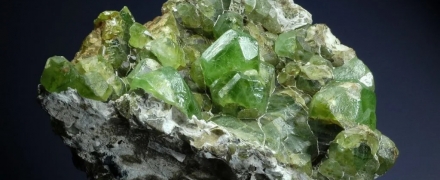open 10 am - 7 pm
laboratory is closed
Chrysolite and its deposits

Along with topaz, amethyst, citrine and other semiprecious stones, such a stone as chrysolite, also known as peridot, is widespread in the jewelry market. Chrysolite is a gem variety of olivine. Its color, due to the admixture of ferrous and ferric iron, varies in a wide range of green and yellow colors.
Chrysolite is a high-temperature mineral and its crystallization is primarily associated with ultrabasic and basaltic melts. In this regard, all primary chrysolite deposits belong to the magmatic and hydrothermal classes.
In magmatic deposits, gem-quality olivine is formed in the early stages of crystallization of magmatic melts in the form of phenocrysts and segregations. It is mainly found in coarse-grained olivine rocks (peridotites, olivinites) included in basalts and kimberlites. Examples of such deposits are the Udachnaya-Vostochnaya kimberlite pipe in Yakutia, Bowell Park kimberlites from the United States, and chrysolite-bearing basalts on the Okononsky plateau.
Hydrothermal high-temperature chrysolite deposits arise mainly in fractured zones of ultrabasic rocks by recrystallization of olivine or serpentinite. This type of deposits includes the Kugdinsky massif along the Taimyr Peninsula.
Placers are also industrially significant deposits of chrysolite. These are mainly eluvial-deluvial (slope) deposits, which are the result of mechanical destruction of chrysolite bedrocks. Such deposits are known in Egypt, the USA, Tanzania, Russia (Eastern Siberia) and Sri Lanka.
В геммологической практике бывают весьма увлекательные случаи с диагностикой ювелирных вставок
Но помимо редкости цвета и высокой стоимости таких камней, многие розовые камни выделяются одной замечательной особенностью – они проявляют плеохроизм, то есть в зависимости от положения осмотра камня он может иметь дополнительные оттенки – оранжевый или пурпурный.
Currently, gemstones are produced by two fundamentally different technological methods - the High Pressure - High Temperature method (“HPHT”, High-pressure & High-temperature) and the Chemical Vapor Deposition (“CVD”, Chemical vapor deposition) method. The "HPHT" method is the most tested classical synthesis method, which can be used both carbon deposition on diamond from flux melts and catalytic reactions. In "CVD" synthesis, diamond growth occurs on a seed during carbon deposition mainly from a gaseous medium at relatively low temperatures and pressures.
Jewelry and precious stones are just such a category of goods, when buying which you need to pay attention to many criteria.
Sogdianite is a rather rare mineral and more often it can be found as a collection material (moreover, in systematic collections), and it is extremely rare in jewelry.






